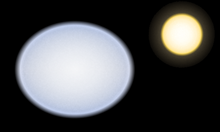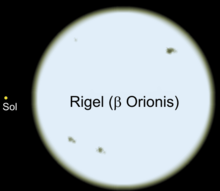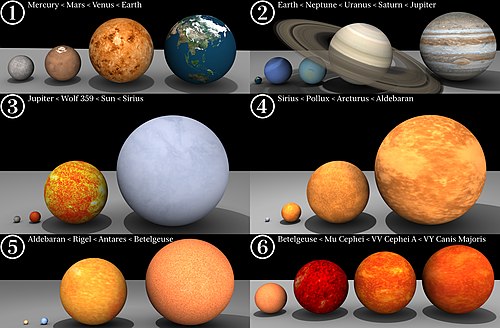Liste sehr großer Sterne
In dieser Liste werden die größten bekannten Sterne, sortiert nach ihrem Radius, aufgelistet. Der Radius ist als Verhältnis zum Sonnenradius angegeben.
Die angegebenen Radien sind Schätzwerte mit teilweise großen Schwankungen. Zudem sind Doppelsternsysteme manchmal in ihre Einzelsterne aufgelöst angegeben, in anderen Fällen als Einzelobjekt aufgeführt. Daher bietet diese Liste nur einen Anhaltspunkt und keine gesicherte Rangfolge.






| Stern | Sonnenradien R☉ (Sonne=1) | Anmerkung | Galaxie |
|---|---|---|---|
| Stephenson 2-18 | 2158[1] | Möglicherweise der größte bekannte Stern. | Milchstraße |
| WOH G64 | 1540[2][3][4][5] | Möglicherweise der größte bekannte Stern.[2] | Große Magellansche Wolke |
| Westerlund 1 W26 (Westerlund 1 BKS AS) | 1530–1580[6] | Einer von 4 roten Überriesen im Sternhaufen Westerlund 1. | Milchstraße |
| RSGC1-F02 | 1499[7]–1549[8] | Riesenstern im RSGC1-Sternhaufen. | Milchstraße |
| LGGS J013414.27+303417.7 | 1479[9] | Dreiecksnebel | |
| WOH S170 | 1461[10] | Große Magellansche Wolke | |
| RSGC1-F01 | 1435[7]–1551[8] | Riesenstern im RSGC1-Sternhaufen. | Milchstraße |
| RSGC1-F04 | 1422[11] | Milchstraße | |
| VY Canis Majoris | 1420[12] | Roter Riesenstern. | Milchstraße |
| KY Cygni | 1420[2] | Milchstraße | |
| CM Velorum | 1416[3] | Milchstraße | |
| AH Scorpii | 1411[13] | Roter Riesenstern. | Milchstraße |
| W60 B90 (WOH S284) | 1390[14] | Große Magellansche Wolke | |
| WOH S281 | 1376[15] | Riesenstern. | Große Magellansche Wolke |
| HV 888 (WOH S140) | 1374[10] | Riesenstern in der großen Magellanschen Wolke. Eine ältere Quelle gibt einen Radius von 1.353 R☉ an.[16] | Große Magellansche Wolke |
| IRAS 05280-6910 | 1367[17] | Riesenstern. | Große Magellansche Wolke |
| S Persei | 1364[18] | Milchstraße | |
| IRAS 04509-6922 | 1360[19] | ||
| VX Sagitarii | 1356[5] | Milchstraße | |
| SMC 18136 | 1310[20] | Riesenstern. | Kleine Magellansche Wolke |
| V774 Sagittarii | 1310[21] | ||
| WOH S279 | 1298[15] | ||
| SW Cephei | 1298[21] | ||
| RW Cygni | 1273[21] | ||
| SP77 46-44 (WOH S341) | 1258[16] | ||
| Westerlund 1-237 | 1245[8] | Einer von 4 roten Überriesen im Sternhaufen Westerlund 1. | Milchstraße |
| HV 2255 (WOH S97) | 1235[15] | ||
| SMC 5092 | 1220[20] | Riesenstern. | Kleine Magellansche Wolke |
| SP77 31-18 (WOH S72) | 1211[15] | ||
| IRC-10414 | 1200[22] | ||
| LMC 175464 | 1200[20] | Riesenstern. | Große Magellansche Wolke |
| LMC 135720 | 1200[20] | Riesenstern. | Große Magellansche Wolke |
| SMC 69886 | 1190[20] | Riesenstern. | Kleine Magellansche Wolke |
| HD 90587 | 1181[21] | ||
| RSGC1-F03 | 1168[7]–1326[8] | Riesenstern im RSGC1-Sternhaufen. | Milchstraße |
| EV Carinae | 1168[16] | ||
| LMC 119219 | 1150[20] | Riesenstern. | Große Magellansche Wolke |
| WOH S264 | 1149[15] | ||
| V602 Carinae | 1142[21] | ||
| MY Cephei | 1135[23] | Nicht zu verwechseln mit My Cephei (Granatstern). | Milchstraße |
| HV 2561 | 1133[15] | Riesenstern. | Große Magellansche Wolke |
| J004035.08+404522.3 | 1130–1230[24] | Riesenstern. | Andromeda-Galaxie |
| LMC 17338 | 1122[15] | Große Magellansche Wolke | |
| VX Sagittarii | 1120–1550[25] | Milchstraße | |
| LMC 141430 | 1110[20] | Riesenstern. | Große Magellansche Wolke |
| IRAS 04516-6902 | 1100[19] | ||
| LMC 175746 | 1100[20] | Große Magellansche Wolke | |
| ST Cephei | 1100[21] | ||
| RSGC1-F08 | 1088[8]–1146[7] | Riesenstern im RSGC1-Sternhaufen. | Milchstraße |
| HV 11423 | 1086[15] | ||
| HV 2084 | 1084[15] | ||
| LMC 174714 | 1080[20] | Große Magellansche Wolke | |
| LMC 68125 | 1080[20] | Große Magellansche Wolke | |
| SMC 49478 | 1080[20] | Kleine Magellansche Wolke | |
| SMC 20133 | 1080[20] | Kleine Magellansche Wolke | |
| Trumpler 27-1 | 1073[26] | Milchstraße | |
| SMC 8930 | 1070[20] | Kleine Magellansche Wolke | |
| V366 Andromedae | 1067[21] | ||
| HR 5171 Aa | 1066[21]–1315[27] | Milchstraße | |
| PZ Cassiopeiae | 1062[26] | Milchstraße | |
| SMC 25879 | 1060[20] | Kleine Magellansche Wolke | |
| IM Cassiopeiae | 1059[21] | ||
| LMC 136042 | 1051[15] | Große Magellansche Wolke | |
| VV Cephei A | 1050[28] | Milchstraße | |
| LMC 142202 | 1050[20] | Große Magellansche Wolke | |
| LMC 146126 | 1050[20] | Große Magellansche Wolke | |
| RSGC1-F05 | 1047[8]–1177[7] | Riesenstern im RSGC1-Sternhaufen. | Milchstraße |
| SMC 10889 | 1046[15] | ||
| LMC 67982 | 1040[20] | Große Magellansche Wolke | |
| SU Persei | 1039[21] | ||
| HV 11262 | 1030[15] | ||
| SMC 83593 | 1019[15] | Kleine Magellansche Wolke | |
| AS Cephei | 1018[21] | ||
| WOH S74 | 1014[15] | ||
| W Persei | 1011[8] | ||
| LMC 143877 | 1010[20] | Große Magellansche Wolke | |
| KW Sagittarii | 1009[13] | Milchstraße | |
| HD 167861 | 1007[21] | ||
| RSGC1-F12 | 1005[8] | Riesenstern im RSGC1-Sternhaufen. | Milchstraße |
| BU Sagittarii | 1005[21] | ||
| Nennenswerte Sterne mit einem Radius unter 1000 R☉ | |||
| Granatstern | 972[29] | Roter Superriese im Sternbild Kepheus. | Milchstraße |
| Westerlund 1-20 | 858–965 | Einer von 4 roten Überriesen im Sternhaufen Westerlund 1. | Milchstraße |
| UY Scuti | 755[26]–941[21] | Roter Superriese im Sternbild Schild. | Milchstraße |
| Beteigeuze | 697[21]–887[30] | Roter Riese im Sternbild Orion. | Milchstraße |
| Antares | 680[31]–707[21] | Roter Riese im Sternbild Skorpion. | Milchstraße |
| Westerlund 1-75 | 668–772 | Einer von 4 roten Überriesen im Sternhaufen Westerlund 1. | Milchstraße |
| Sonne | 1 | Milchstraße | |

1. Merkur < Mars < Venus < Erde
2. Erde < Neptun < Uranus < Saturn < Jupiter
3. Jupiter < Wolf 359 < Sonne < Sirius
4. Sirius < Pollux < Arktur < Aldebaran
5. Aldebaran < Rigel < Antares < Beteigeuze
6. Beteigeuze < Granatstern < VV Cephei A < VY Canis Majoris (< Stephenson 2-18)
Siehe auch
- Liste der Sterne
- Liste der hellsten Sterne
- Liste der massereichsten Sterne
- Liste der nächsten Sterne und Braunen Zwerge
- Liste der Doppel- und Mehrfachsterne
Weblinks
- Die drei größten Sterne identifiziert (englisch) bei BBC News
- Die drei größten Sterne identifiziert (englisch) bei Slashdot
Einzelnachweise
- ↑ Thomas K. T. Fok, Jun-ichi Nakashima, Bosco H. K. Yung, Chih-Hao Hsia, Shuji Deguchi: Maser Observations of Westerlund 1 and Comprehensive Considerations on Maser Properties of Red Supergiants Associated with Massive Clusters. In: The Astrophysical Journal. Band 760, Nr. 1, 20. November 2012, ISSN 0004-637X, S. 65, doi:10.1088/0004-637X/760/1/65, arxiv:1209.6427.
- ↑ a b c Emily M. Levesque, Philip Massey, Bertrand Plez, Knut A. G. Olsen: THE PHYSICAL PROPERTIES OF THE RED SUPERGIANT WOH G64: THE LARGEST STAR KNOWN? In: The Astronomical Journal. Band 137, Nr. 6, 1. Juni 2009, ISSN 0004-6256, S. 4744–4752, doi:10.1088/0004-6256/137/6/4744.
- ↑ a b S. de Wit, A.Z. Bonanos, F. Tramper, M. Yang, G. Maravelias, K. Boutsia, N. Britavskiy, E. Zapartas: Properties of luminous red supergiant stars in the Magellanic Clouds. In: Astronomy & Astrophysics. Band 669, Januar 2023, ISSN 0004-6361, S. A86, doi:10.1051/0004-6361/202243394.
- ↑ Emily M Levesque: Physical Properties of Red Supergiants. In: Astrophysics of Red Supergiants. IOP Publishing, 2017, ISBN 978-0-7503-1329-2, S. 3–1–3–13, doi:10.1088/978-0-7503-1329-2ch3.
- ↑ a b Emma R. Beasor, Nathan Smith: The Extreme Scarcity of Dust-enshrouded Red Supergiants: Consequences for Producing Stripped Stars via Winds. In: The Astrophysical Journal. Band 933, Nr. 1, 1. Juli 2022, ISSN 0004-637X, S. 41, doi:10.3847/1538-4357/ac6dcf.
- ↑ Nicholas J. Wright, Roger Wesson, Janet E. Drew, Geert Barentsen, Michael J. Barlow: The Ionized Nebula surrounding the Red Supergiant W26 in Westerlund 1. In: Monthly Notices of the Royal Astronomical Society: Letters. Band 437, Nr. 1, 2014, ISSN 1745-3925, S. L1–L5, doi:10.1093/mnrasl/slt127, arxiv:1309.4086.
- ↑ a b c d e Ben Davies, Don F. Figer, Casey J. Law, Rolf-Peter Kudritzki, Francisco Najarro: The cool supergiant population of the massive young star cluster RSGC1. In: The Astrophysical Journal. Band 676, Nr. 2, 2008, ISSN 0004-637X, S. 1016–1028, doi:10.1086/527350, arxiv:0711.4757.
- ↑ a b c d e f g h Thomas K. T. Fok, Jun-ichi Nakashima, Bosco H. K. Yung, Chih-Hao Hsia, Shuji Deguchi: Maser Observations of Westerlund 1 and Comprehensive Considerations on Maser Properties of Red Supergiants Associated with Massive Clusters. In: The Astrophysical Journal. Band 760, Nr. 1, 2012, ISSN 0004-637X, S. 65, doi:10.1088/0004-637X/760/1/65, arxiv:1209.6427.
- ↑ Emily M. Levesque, Philip Massey, Bertrand Plez, Knut A. G. Olsen: The Physical Properties of the Red Supergiant WOH G64: The Largest Star Known? In: The Astronomical Journal. Band 137, Nr. 6, 2009, ISSN 0004-6256, S. 4744–4752, doi:10.1088/0004-6256/137/6/4744, arxiv:0903.2260.
- ↑ a b Philip Massey, Kathryn F. Neugent, Sylvia Ekström, Cyril Georgy, Georges Meynet: The Time-averaged Mass-loss Rates of Red Supergiants as Revealed by Their Luminosity Functions in M31 and M33. In: The Astrophysical Journal. Band 942, Nr. 2, 1. Januar 2023, ISSN 0004-637X, S. 69, doi:10.3847/1538-4357/aca665.
- ↑ Roberta M. Humphreys, Greta Helmel, Terry J. Jones, Michael S. Gordon: Exploring the Mass Loss Histories of the Red Supergiants. In: The Astronomical Journal. 160. Jahrgang, Nr. 3, August 2020, S. 145, doi:10.3847/1538-3881/abab15, arxiv:2008.01108, bibcode:2020AJ....160..145H (englisch).
- ↑ M. Wittkowski, P. H. Hauschildt, B. Arroyo Torres, J. M. Marcaide: Fundamental properties and atmospheric structure of the red supergiant VY CMa based on VLTI/AMBER spectro-interferometry. In: Astronomy & Astrophysics. Band 540, 2012, ISSN 0004-6361, S. L12, doi:10.1051/0004-6361/201219126, arxiv:1203.5194.
- ↑ a b B. Arroyo-Torres, M. Wittkowski, J. M. Marcaide, P. H. Hauschildt: The atmospheric structure and fundamental parameters of the red supergiants AH Sco, UY Sct and KW Sgr. In: Astronomy & Astrophysics. Band 554, Juni 2013, ISSN 0004-6361, S. A76, doi:10.1051/0004-6361/201220920, arxiv:1305.6179.
- ↑ S. de Wit, A.Z. Bonanos, F. Tramper, M. Yang, G. Maravelias, K. Boutsia, N. Britavskiy, E. Zapartas: Properties of luminous red supergiant stars in the Magellanic Clouds. In: Astronomy & Astrophysics. Band 669, Januar 2023, ISSN 0004-6361, S. A86, doi:10.1051/0004-6361/202243394.
- ↑ a b c d e f g h i j k l m n Martin A. T. Groenewegen, Greg C. Sloan: Luminosities and mass-loss rates of Local Group AGB stars and Red Supergiants. In: Astronomy & Astrophysics. Band 609, 2018, ISSN 0004-6361, S. A114, doi:10.1051/0004-6361/201731089, arxiv:1711.07803.
- ↑ a b c Jacco Th van Loon, Maria-Rosa L. Cioni, Albert A. Zijlstra, Cecile Loup: An empirical formula for the mass-loss rates of dust-enshrouded red supergiants and oxygen-rich Asymptotic Giant Branch stars. In: Astronomy & Astrophysics. Band 438, Nr. 1, 2005, ISSN 0004-6361, S. 273–289, doi:10.1051/0004-6361:20042555, arxiv:astro-ph/0504379.
- ↑ Steven R. Goldman, Jacco Th. van Loon, Albert A. Zijlstra, James A. Green, Peter R. Wood, Ambra Nanni, Hiroshi Imai, Patricia A. Whitelock, Mikako Matsuura, Martin A. T. Groenewegen, José F. Gómez: The wind speeds, dust content, and mass-loss rates of evolved AGB and RSG stars at varying metallicity. In: Monthly Notices of the Royal Astronomical Society. Band 465, Nr. 1, 11. Februar 2017, ISSN 0035-8711, S. 403–433, doi:10.1093/mnras/stw2708.
- ↑ Ryan P. Norris: Seeing Stars Like Never Before: A Long-term Interferometric Imaging Survey of Red Supergiants. Georgia State University, 2019, abgerufen am 22. Dezember 2023.
- ↑ a b Jonathan R. Marshall, Jacco Th van Loon, Mikako Matsuura, Peter R. Wood, Albert A. Zijlstra: The AGB superwind speed at low metallicity. In: Monthly Notices of the Royal Astronomical Society. Band 355, Nr. 4, Dezember 2004, S. 1348–1360, doi:10.1111/j.1365-2966.2004.08417.x, arxiv:astro-ph/0410120.
- ↑ a b c d e f g h i j k l m n o p q r Emily M. Levesque, Philip Massey, K. A. G. Olsen, Bertrand Plez, George Meynet: The Effective Temperatures and Physical Properties of Magellanic Cloud Red Supergiants: The Effects of Metallicity. In: The Astrophysical Journal. Band 645, Nr. 2, 10. Juli 2006, ISSN 0004-637X, S. 1102–1117, doi:10.1086/504417, arxiv:astro-ph/0603596.
- ↑ a b c d e f g h i j k l m n o p P. Cruzalèbes, R. G. Petrov, S. Robbe-Dubois, J. Varga, L. Burtscher: A catalogue of stellar diameters and fluxes for mid-infrared interferometry. In: Monthly Notices of the Royal Astronomical Society. Band 490, Nr. 3, 11. Dezember 2019, ISSN 0035-8711, S. 3158–3176, doi:10.1093/mnras/stz2803, arxiv:1910.00542.
- ↑ V. V. Gvaramadze, K. M. Menten, A. Y. Kniazev, N. Langer, J. Mackey: IRC-10414: a bow-shock-producing red supergiant star. In: Monthly Notices of the Royal Astronomical Society. Band 437, Nr. 1, 1. Januar 2014, ISSN 0035-8711, S. 843–856, doi:10.1093/mnras/stt1943, arxiv:1310.2245.
- ↑ Emma R. Beasor, Ben Davies: The evolution of red supergiant mass-loss rates. In: MNRAS. Band 475, Nr. 1, März 2018, ISSN 0035-8711, S. 55–62, doi:10.1093/mnras/stx3174, bibcode:2018MNRAS.475...55B.
- ↑ Philip Massey, David R. Silva, Emily M. Levesque, Bertrand Plez, Knut A. G. Olsen: Red Supergiants in the Andromeda Galaxy (M31). In: The Astrophysical Journal. Band 703, Nr. 1, 20. September 2009, ISSN 0004-637X, S. 420–440, doi:10.1088/0004-637X/703/1/420, arxiv:0907.3767.
- ↑ Shuangjing Xu, Bo Zhang, Mark J. Reid, Karl M. Menten, Xingwu Zheng: The Parallax of the Red Hypergiant VX Sgr with Accurate Tropospheric Delay Calibration. In: The Astrophysical Journal. Band 859, Nr. 1, 17. Mai 2018, ISSN 1538-4357, S. 14, doi:10.3847/1538-4357/aabba6, arxiv:1804.00894.
- ↑ a b c Maria Messineo, Anthony G. A. Brown: A catalog of known Galactic K-M stars of class I, candidate RSGs, in Gaia DR2. In: The Astronomical Journal. Band 158, Nr. 1, 18. Juni 2019, ISSN 1538-3881, S. 20, doi:10.3847/1538-3881/ab1cbd, arxiv:1905.03744.
- ↑ O. Chesneau, A. Meilland, E. Chapellier, F. Millour, A. M. Van Genderen: The yellow hypergiant HR 5171 A: Resolving a massive interacting binary in the common envelope phase. In: Astronomy & Astrophysics. Band 563, März 2014, ISSN 0004-6361, S. A71, doi:10.1051/0004-6361/201322421, arxiv:1401.2628.
- ↑ Wendy Hagen Bauer, Theodore R. Gull, Philip D. Bennett: Spatial Extension in the Ultraviolet Spectrum of VV Cephei. In: AJ. Band 136, Nr. 3, September 2008, ISSN 0004-6256, S. 1312–1324, doi:10.1088/0004-6256/136/3/1312, bibcode:2008AJ....136.1312H.
- ↑ M. Montargès, W. Homan, D. Keller, N. Clementel, S. Shetye: NOEMA maps the CO $J = 2-1$ environment of the red supergiant $\mu$ Cep. In: Monthly Notices of the Royal Astronomical Society. Band 485, Nr. 2, 11. Mai 2019, ISSN 0035-8711, S. 2417–2430, doi:10.1093/mnras/stz397, arxiv:1903.07129.
- ↑ Michelle M. Dolan, Grant J. Mathews, Doan Duc Lam, Nguyen Quynh Lan, Gregory J. Herczeg: Evolutionary tracks for Betelgeuse. In: The Astrophysical Journal. Band 819, Nr. 1, 23. Februar 2016, ISSN 1538-4357, S. 7, doi:10.3847/0004-637X/819/1/7, arxiv:1406.3143.
- ↑ Keiichi Ohnaka, Karl-Heinz Hofmann, Dieter Schertl, Gerd Weigelt, Carlo Baffa: High spectral resolution imaging of the dynamical atmosphere of the red supergiant Antares in the CO first overtone lines with VLTI/AMBER. In: Astronomy & Astrophysics. Band 555, Juli 2013, ISSN 0004-6361, S. A24, doi:10.1051/0004-6361/201321063, arxiv:1304.4800.
Auf dieser Seite verwendete Medien
Autor/Urheber: Dave Jarvis (https://dave.autonoma.ca/), Lizenz: CC BY-SA 3.0
Größenvergleich bekannter Planeten und Sterne
Autor/Urheber: MuCepheiBetelgeuse, Lizenz: CC BY-SA 4.0
Comparison of Radii of the 4 known RSGs located in the Westerlund 1 star cluster, in particular Westerlund 1-26, Westerlund 1-237, Westerlund 1-20, Westerlund 1-75
Autor/Urheber: CWitte, Lizenz: CC BY-SA 3.0
Size comparison between sun and the blue giant star Rigel(beta Ori), which has a diameter approx. 60 times bigger than the sun's.
Autor/Urheber: RJHall, Lizenz: CC BY-SA 3.0
This illustration compares the rapidly rotating Vega (left) to the smaller Sun (right).
Autor/Urheber:
- Alnitak sun comparison.svg, Alnitak sun comparision.png: CWitte
- derivative work: Urutseg (Diskussion)
- derivative work: CWitte
German version - deutsche Version
Size comparision between sun and the blue giant star Alnitak (zeta Ori), which is approx. 20 times bigger than the sun.Autor/Urheber: , Lizenz: Bild-frei
Das Bild zeigt das Grössenverhältnis zwischen Sonne und VV Cephei A.






